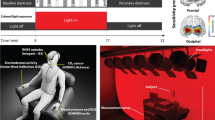Abstract
Background: Sex differences in behavioural performance of a cognitive task have been repeatedly reported in the literature. Whether such differences are also relevant for evoked cerebral haemodynamic and oxygenation responses as well as systemic physiological changes is a topic of ongoing investigations. Aim: We investigated whether changes in cerebral oxygenation and systemic physiological activity are sex-dependent during a verbal fluency task (VFT). Subjects and methods: VFT performance and changes in cerebral oxygenation and systemic physiology were investigated in 32 healthy right-handed adults (17 females, 15 males, age: 25.5 ± 4.3 years). The total duration of the VFT was 9 min. During this phase, subjects were also exposed to blue light (peak wavelength: 450 nm, illuminance: 120 lux). Before and after the VFT, subjects were in darkness. In this study, we used the systemic physiology augmented functional near-infrared spectroscopy (SPA-fNIRS) approach. Absolute concentration changes of oxyhaemoglobin ([O2Hb]), deoxyhaemoglobin ([HHb]), total haemoglobin ([tHb]), as well as tissue oxygen saturation (StO2) were measured bilaterally over the prefrontal cortex (PFC) and visual cortex (VC). Systemic physiological parameters were also recorded in parallel (e.g., end-tidal CO2, heart rate, respiration rate, skin conductance). Results: We found that: (i) Females were better VFT performers in comparison to males. (ii) Changes in [O2Hb] and [HHb] in the VC were higher for males compared to females during the VFT under blue light exposure. (iii) Lower and higher StO2 changes were detected for males compared to females in the PFC and VC, respectively. (iv) Sex-dependent changes were also evident for end-tidal CO2, heart rate, respiration rate, and pulse-respiration quotient. Conclusions: Our study showed that sex differences are not only observed in task performance but also in the magnitudes of changes in cerebral and physiological parameters. The findings of the current study emphasise that sex differences in brain activation and systemic physiological activity need to be considered when interpreting functional neuroimaging data. These findings offer a broad range of implications for educational purposes and facilitate a better understanding of the effects of sex on behavioural performance as well as human physiology.
Access this chapter
Tax calculation will be finalised at checkout
Purchases are for personal use only
Similar content being viewed by others
References
Weiss EM, Siedentopf C, Hofer A et al (2003) Brain activation pattern during a verbal fluency test in healthy male and female volunteers: a functional magnetic resonance imaging study. Neurosci Lett 352:191–194
Spets DS, Slotnick SD (2020) Are there sex differences in brain activity during long-term memory? A systematic review and fMRI activation likelihood estimation meta-analysis. Cogn Neurosci 12(3–4):163–173
Zohdi H, Scholkmann F, Wolf U (2020) Long-term blue light exposure changes frontal and occipital cerebral hemodynamics: not all Subjects React the Same. Adv Exp Med Biol 1269:217–222
Scholkmann F, Hafner T, Metz AJ et al (2017) Effect of short-term colored-light exposure on cerebral hemodynamics and oxygenation, and systemic physiological activity. Neurophotonics 4:045005
Metz AJ, Klein SD, Scholkmann F, Wolf U (2017) Continuous coloured light altered human brain haemodynamics and oxygenation assessed by systemic physiology augmented functional near-infrared spectroscopy. Sci Rep 7:10027
Zohdi H, Egli R, Guthruf D et al (2021) Color-dependent changes in humans during a verbal fluency task under colored light exposure assessed by SPA-fNIRS. Sci Rep 11:9654
Zohdi H, Scholkmann F, Wolf U (2021) Individual differences in hemodynamic responses measured on the head due to a long-term stimulation involving colored light exposure and a cognitive task: a SPA-fNIRS study. Brain Sci 11:54
Benedek M, Kaernbach C (2010) A continuous measure of phasic electrodermal activity. J Neurosci Methods 190:80–91
Scheuringer A, Wittig R, Pletzer B (2017) Sex differences in verbal fluency: the role of strategies and instructions. Cogn Process 18:407–417
Vanston JE, Strother L (2017) Sex differences in the human visual system. J Neurosci Res 95:617–625
Scholkmann F, Wolf U (2019) The pulse-respiration quotient: a powerful but untapped parameter for modern studies about human physiology and pathophysiology. Front Physiol 10:1–18
Minhas JS, Panerai RB, Robinson TG (2018) Sex differences in cerebral haemodynamics across the physiological range of PaCO2. Physiol Meas 39:105009
Acknowledgements
The financial support of the Software AG Foundation, Christophorus Foundation, and Graduate School for Health Sciences at the University of Bern is gratefully acknowledged.
Author information
Authors and Affiliations
Corresponding author
Editor information
Editors and Affiliations
Rights and permissions
Copyright information
© 2022 Springer Nature Switzerland AG
About this paper
Cite this paper
Zohdi, H., Scholkmann, F., Wolf, U. (2022). Changes in Cerebral Oxygenation and Systemic Physiology During a Verbal Fluency Task: Differences Between Men and Women. In: Scholkmann, F., LaManna, J., Wolf, U. (eds) Oxygen Transport to Tissue XLIII. Advances in Experimental Medicine and Biology, vol 1395. Springer, Cham. https://doi.org/10.1007/978-3-031-14190-4_3
Download citation
DOI: https://doi.org/10.1007/978-3-031-14190-4_3
Published:
Publisher Name: Springer, Cham
Print ISBN: 978-3-031-14189-8
Online ISBN: 978-3-031-14190-4
eBook Packages: Biomedical and Life SciencesBiomedical and Life Sciences (R0)




